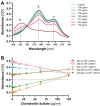Analysis of Urinary Glycosaminoglycans to Predict Outcome in COVID-19 and Community-Acquired Pneumonia-A Proof-of-Concept Study
- PMID: 37629312
- PMCID: PMC10455319
- DOI: 10.3390/jcm12165269
Analysis of Urinary Glycosaminoglycans to Predict Outcome in COVID-19 and Community-Acquired Pneumonia-A Proof-of-Concept Study
Abstract
Although coronavirus disease 2019 (COVID-19) is considered a systemic disease associated with vascular inflammation and eventual destruction of the protective endothelial glycocalyx (eGC), biomarkers of eGC damage are not yet available in the clinic. The most prominent components of eGC are sulphated glycosaminoglycans (sGAGs) attached to core proteoglycans. We hypothesised that the amount of sGAG fragments shed in urine (as a surrogate for systemic eGC damage) would correlate with disease severity and outcome. Total urinary sGAG concentration was measured using an in-house optimised 1,9-dimethylmethylene blue (DMMB) assay, which is highly accurate and insensitive to interferences. The median urinary sGAG concentration was significantly higher in 67 hospitalised patients with COVID-19 compared to 72 hospitalised patients with community-acquired pneumonia (CAP). In both groups, urinary sGAG concentrations predicted a combined endpoint (including intubation and death) with an area under the receiver operator characteristic curve of 0.72 (95% CI 0.55-0.88, p = 0.01) and 0.70 (95% CI 0.57-0.83, p = 0.007), respectively. In conclusion, the inexpensive and easy-to-perform DMMB assay provides a surrogate parameter for eGC damage that may be useful for risk stratification of patients with COVID-19 and CAP.
Keywords: 1,9-dimethylmethylene blue (DMMB); COVID-19; community-acquired pneumonia; endothelial dysfunction; endothelial glycocalyx; endotheliopathy; glycosaminoglycans.
Conflict of interest statement
The authors declare no conflict of interest. The funders had no role in the design of the study; in the collection, analyses, or interpretation of data; in the writing of the manuscript; or in the decision to publish the results.
Figures



References
-
- Smadja D.M., Mentzer S.J., Fontenay M., Laffan M.A., Ackermann M., Helms J., Jonigk D., Chocron R., Pier G.B., Gendron N., et al. COVID-19 is a systemic vascular hemopathy: Insight for mechanistic and clinical aspects. Angiogenesis. 2021;24:755–788. doi: 10.1007/s10456-021-09805-6. - DOI - PMC - PubMed
Grants and funding
LinkOut - more resources
Full Text Sources
Miscellaneous

